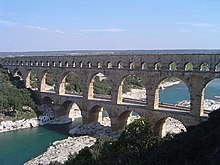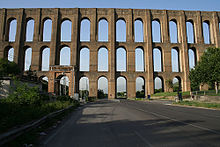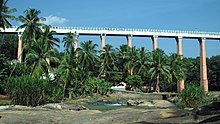User:Nankai/Aqueduct (bridge)


Bridges for conveying water, called aqueducts or water bridges are constructed to convey watercourses across gaps such as valleys or ravines. The term aqueduct often refers to the entire watercourse as well as the bridge.[1] Large navigable aqueducts are used as transport links for boats or ships. Aqueducts must span a crossing at the same level as the watercourses on each end. The word is derived from the Latin aqua ("water") and ducere ("to lead").[2]
Ancient bridges for water[edit]

Although particularly associated with the Romans, bridges for conveying water were used as early as the 7th century BCE, when the Assyrians built an 80 km long limestone aqueduct, which included a 10 m high section to cross a 300 m wide valley, to carry water to their capital city, Nineveh.[3]
Roman Empire[edit]
Bridges were a distinctive feature of Roman aqueducts which were built in all parts of the Roman Empire, from Germany to Africa, and especially in the city of Rome, where they supplied water to public baths and for drinking water. Roman aqueduct bridges set a standard of engineering that was not surpassed for more than a thousand years.

Sri Lanka[edit]
Extensive usage of elaborate aqueduct bridges have been found to have been used in Ancient Sri Lanka.
Modern bridges for water[edit]
[edit]
Navigable aqueducts, also called water bridges, are water-filled bridges to allow vessels on a waterway to cross ravines or valleys. During the Industrial Revolution of the 18th century, navigable aqueducts were constructed as part of the boom in canal-building. A notable revolving aqueduct has been made on the Bridgewater Canal. This allowed vessels to cross at high and low levels while conserving water (compared to building locks).
Pipeline bridge[edit]
A modern version of an aqueduct is a pipeline bridge.
Uses[edit]

Notable bridges for conveying water[edit]
Roman aqueducts[edit]


- The Pont du Gard in southern France
- Barbegal aqueduct, France
- Aqueduto de São Sebastião, in Coimbra, Portugal
- Eifel aqueduct, Germany
- Caesarea Maritima, Israel
- Patras, Greece
- Aqueduct of Segovia, Spain
- Acueducto de los Milagros, Mérida, Spain
- Tarragona, Spain
- Almuñécar, Spain (5 aqueducts – 4 still in use)
- Valens Aqueduct, Istanbul, Turkey
- Aqua Augusta, Italy
- Aqua Claudia and the Anio Novus, as part of the Porta Maggiore, Rome, Italy
- Skopje Aqueduct, Skopje, Republic of Macedonia
Other aqueducts[edit]



- Wignacourt Aqueduct, Malta; built in the 16th century to transport water from the old capital city of Malta, Mdina to the new capital city Valletta; today, only part is visible in the localities of Balzan, Birkirkara and Santa Venera
- Aqueduct St-Clément, Montpellier, France – 17th century
- Bar Aqueduct, Montenegro – 16th century
- Águas Livres Aqueduct, in Lisbon, Portugal (built 1731–1748)
- Aqueduto de Óbidos, in Óbidos, Portugal (built 1570)
- Aqueduto de Setúbal in Setúbal, Portugal (built 1696)
- Aqueduto dos Pegões in Tomar, Portugal (built 1593)
- Água de Prata Aqueduct, in Évora, Portugal (built 1531–1537)
- Santa Clara Aqueduct, in Vila do Conde, Portugal
- Carioca Aqueduct in Rio de Janeiro, Brazil (built 1744–1750)
- Aqueduct of Teruel, Spain
- Roquefavour aqueduct, France – built between 1842 and 1847
- Winnipeg Aqueduct, Manitoba, Canada – built between 1915 and 1919
- Mathur Aqueduct in Tamilnadu state, India
- Pontcysyllte Aqueduct in Wales
- Longdon-on-Tern Aqueduct the worlds first Cast Iron Navigable Aqueduct, designed by Thomas Telford
- Surviving Spanish aqueducts in Mexico:
- Aqueduct of Querétaro, Mexico – built between 1726 and 1738, 1.3 km long and featuring 74 arches
- Aqueduct of Morelia, Michoacán, built between 1735 and 1738
- Aqueduct of Acámbaro, Guanajuato, built in 1528[4]
- Chapultepec aqueduct, Mexico D.F.
- Kavala aqueduct, 16th-century Ottoman aqueduct in Kavala, Greece
- High Bridge, part of the former Croton Aqueduct, built in 1848, is the oldest surviving bridge in New York City
Gallery[edit]
-
Aqueduct in Segovia, Spain
-
Traditional homes built between the arches of the Água de Prata Aqueduct in Évora, Portugal
-
A small disused aqueduct in Leeds, England
See also[edit]
- List of aqueducts
- List of canal aqueducts in the United Kingdom
- List of Roman aqueduct bridges
- Pipeline – some used to carry water
- Roman architecture
- Roman engineering
- Water resources
Notes[edit]
- ^ "aqueduct", Britannica CD 2000
- ^ "aqueduct", Britannica CD 2000
- ^ Thorkild Jacobsen and Seton Lloyd, Sennacherib's Aqueduct at Jerwan, Oriental Institute Publication 24, University of Chicago Press, 1935]
- ^ Mexico – Travel
References[edit]
- Sextus Julius Frontinus, De Aquaeductu Urbis Romae (On the water management of the city of Rome), Translated by R. H. Rodgers, 2003, University of Vermont
- Aqueduct entry from Encyclopædia Britannica Eleventh Edition
- Chanson, H. (2002). Certains Aspects de la Conception hydrauliques des Aqueducs Romains. ('Some Aspect on the Hydraulic Design of Roman Aqueducts.') Journal La Houille Blanche, No. 6/7, pp. 43–57 (ISSN 0018-6368)
- Chanson, H. (2008). "The Hydraulics of Roman Aqueducts: What do we know? Why should we learn?" in Proceedings of World Environmental and Water Resources Congress 2008 Ahupua'a, ASCE-EWRI Education, Research and History Symposium, Hawaii, USA, Invited Keynote lecture, 13–16 May, R.W. Badcock Jr and R. Walton Eds., 16 pages (ISBN 978-0-7844-0976-3)
External links[edit]
Category:Water Category:Bridges by mode of traffic Category:Water transport infrastructure Category:Water supply Category:Routes







